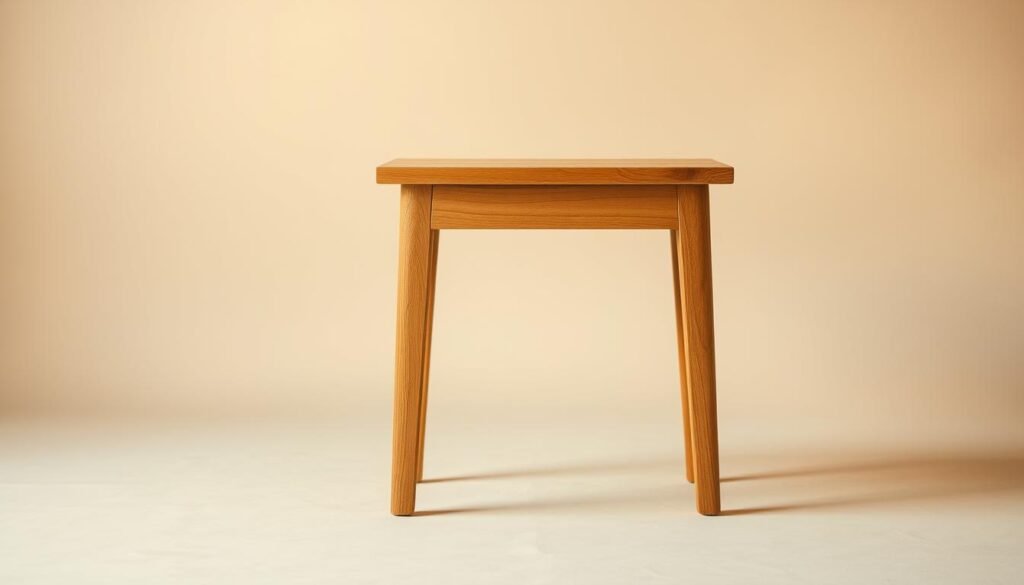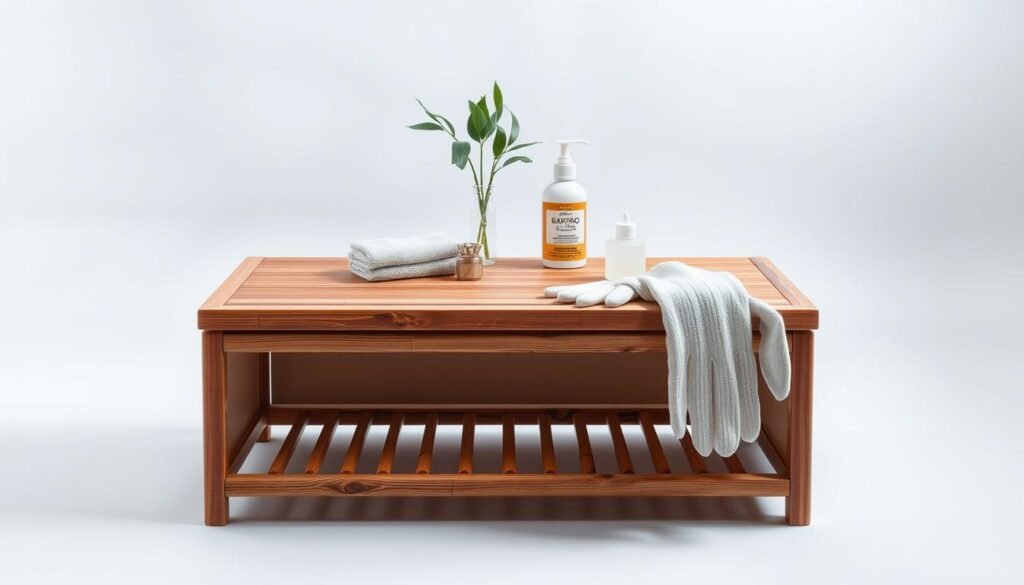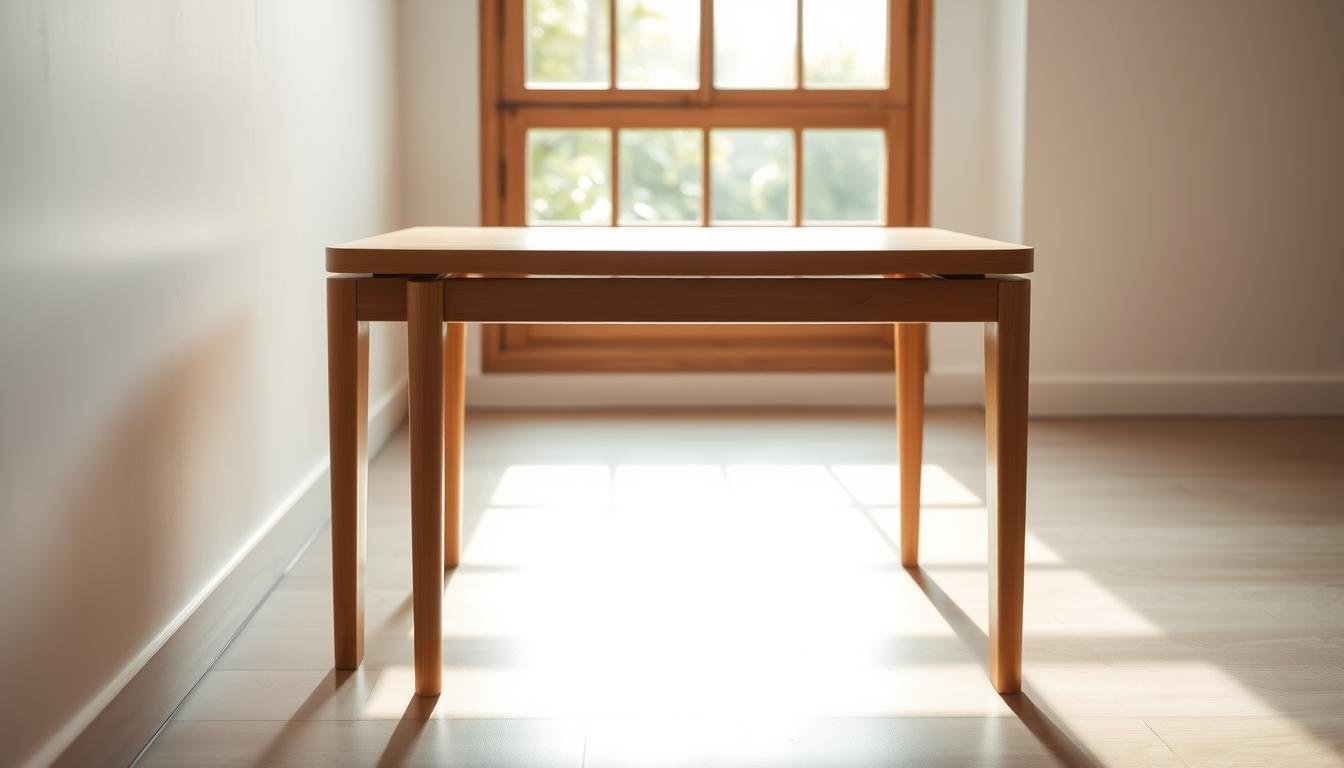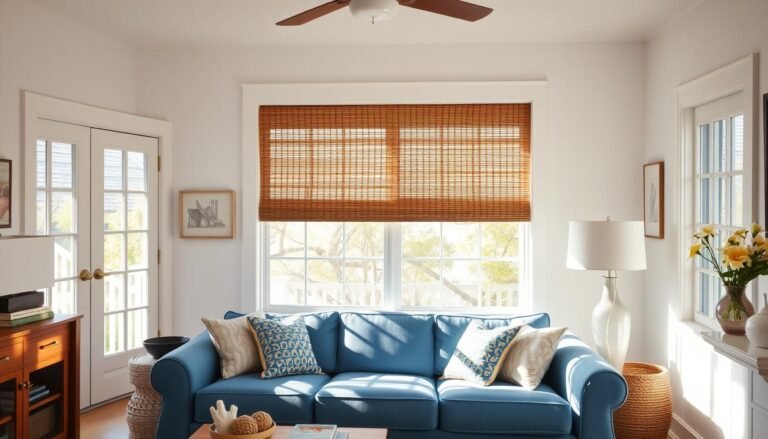Are you torn between the natural charm of wooden furniture and the eco-friendly appeal of bamboo when it comes to choosing the perfect side table for your home?
Choosing between bamboo and wooden side tables can be tough. Bamboo is a fast-growing, renewable resource. It’s eco-friendly, has natural antibacterial properties, and resists moisture.
Wooden side tables, on the other hand, offer a classic look that fits any home decor. We’ll look at the pros and cons of each material. This includes durability, sustainability, and price to help you decide.
Key Takeaways
- Eco-friendliness of bamboo as a fast-growing renewable resource
- Durability and moisture resistance of bamboo furniture
- Timeless aesthetic appeal of wooden side tables
- Comparison of price ranges for bamboo and wooden side tables
- Factors to consider when choosing between bamboo and wood
Understanding Bamboo Side Tables
Bamboo side tables are a standout in sustainable furniture. Bamboo is a fast-growing, renewable resource. It’s becoming popular for its eco-friendly qualities and beauty.
What Makes Bamboo Unique?
Bamboo is sustainable and has natural antibacterial properties. It grows quickly, ready in three to five years. This is much faster than traditional wood, which takes decades.
This fast growth makes bamboo a green choice. It’s also moisture resistant, less likely to get damaged by spills or humidity. Its antibacterial nature makes bamboo furniture a healthy option for homes.
Key Characteristics of Bamboo
Bamboo’s unique texture and look make it popular in furniture. It adds warmth and character to any room. Its durability and resistance to wear and tear make it practical for side tables and more.
- Durability: Bamboo is strong and can handle daily use.
- Sustainability: Bamboo is a green alternative to traditional wood.
- Aesthetic Appeal: Bamboo’s texture and look bring a natural, warm feel to decor.
Common Uses for Bamboo Furniture
Bamboo furniture, like side tables, is versatile. It fits well in modern and traditional decor. Its eco-friendly nature appeals to those wanting to reduce their environmental impact.
Here are some common uses for bamboo furniture:
- Living rooms and bedrooms for a cozy, natural feel.
- Outdoor spaces, where its moisture resistance is a plus.
- Eco-friendly and sustainable living spaces, appealing to environmentally conscious people.
Advantages of Bamboo Side Tables
Bamboo side tables are a top pick for those who care about the planet. Bamboo grows fast and needs little to no chemicals, making it great for the environment.
Eco-Friendliness and Sustainability
Bamboo is super sustainable for making furniture. It grows quickly, ready in just three to five years. This is way faster than wood, which takes decades.
This fast growth and ability to regrow make bamboo exceptionally eco-friendly.
- Bamboo sucks up more carbon dioxide and makes more oxygen than many plants.
- It uses little water and no harmful chemicals, cutting down its environmental impact.
- Bamboo can be harvested without harming the plant, so it can grow back.
Lightweight and Versatile Design
Bamboo side tables are not just good for the planet. They’re also lightweight and versatile. Bamboo’s natural bend lets it be shaped into many designs, from modern to traditional.
Because bamboo is light, it’s easy to move around your home. Plus, it can be mixed with other materials for unique, useful pieces.
Unique Aesthetic Appeal
Bamboo side tables add a special look to any room. Their natural texture and color warm up the space. Each piece of bamboo is one-of-a-kind.
With their design flexibility and natural beauty, these tables are a stylish choice for any home. They fit well with many decor styles, from simple to rustic.
Disadvantages of Bamboo Side Tables
Bamboo side tables have their downsides. Knowing these can help you decide better. They have many good points, but there are some not-so-good ones too.
One big issue is that bamboo side tables can scratch and dent easily. This is because bamboo is more likely to get damaged, mainly if it’s not well-finished or cared for. Scratches and dents can ruin the look and make the table less durable.
Potential for Scratching and Dents
Bamboo is very sensitive to scratches and dents. To avoid this, you should be gentle with your bamboo side tables. Also, think about using a protective finish to make them less likely to get damaged.
- Use coasters and placemats to protect the surface from spills and scratches.
- Avoid placing heavy objects on the table that could cause denting.
- Regularly dust the table to prevent dirt from accumulating and causing scratches.
Limited Color and Finish Options
Bamboo side tables also have a limited choice of colors and finishes. Bamboo’s natural look and grain can be both a plus and a minus. Some people love it, while others might find it too simple.
To get around this, some makers offer different finishes to make bamboo look better. But, the choices might not be as wide as with other materials like wood.
Knowing these downsides helps you make better choices. It also lets you take steps to keep your bamboo side tables looking great and working well in your home.
Wooden Side Tables: Pros and Cons
Wooden side tables have their own set of benefits and drawbacks. They can be a great addition to your home, but only if they fit your needs.
Advantages of Wooden Side Tables
Wooden side tables are very durable and last a long time. They can handle daily use well, making them perfect for active homes. Wood also adds a special warmth and charm to any room.
- Durability: Wooden side tables are more durable than bamboo ones.
- Aesthetic Appeal: Wood’s natural beauty can make any room unique.
- Versatility: Wood can be stained or painted to fit different styles.

Disadvantages of Wooden Side Tables
Wooden side tables also have some downsides. They might cost more than bamboo ones, and their environmental impact is a worry if the wood isn’t sustainably sourced. Plus, wood needs regular polishing or sealing to keep looking good.
| Characteristics | Wooden Side Tables | Bamboo Side Tables |
|---|---|---|
| Durability | High | Medium |
| Environmental Impact | Variable | Low |
| Maintenance | Periodic polishing/sealing | Occasional dusting |
In summary, wooden side tables are durable and look great, but think about their environmental impact and upkeep. By considering these points, you can choose the right side table for your home and values.
Price Ranges for Bamboo and Wooden Side Tables
Bamboo and wooden side tables have different prices. This is because of many factors. Knowing these can help you choose the right one for your budget and taste.
Estimated Costs of Bamboo Side Tables
Bamboo side tables are usually cheaper. They cost between $40 and $111. The price depends on the bamboo quality, how it’s made, and its design.
A simple bamboo side table might cost less. But a more detailed one will cost more.
Estimated Costs of Wooden Side Tables
Wooden side tables can cost between $44 and $174. The price changes based on the wood type. Hardwoods like oak and teak are pricier than softwoods.
The table’s build quality and extra features also affect the price. For example, a table with drawers or carvings will cost more.
Factors Affecting Price Differences
Several things make bamboo and wooden side tables cost different:
- Material Sourcing: The cost and availability of raw materials (bamboo vs. wood) can significantly affect the final product price.
- Craftsmanship: The skill level and time required to craft each piece can vary, influencing the cost.
- Design and Features: Tables with more complex designs or additional features like storage will generally be more expensive.
- Brand and Quality: Reputable brands and high-quality products often command higher prices due to their durability and aesthetic appeal.
Understanding these factors helps you see why bamboo and wooden side tables have different prices. This way, you can choose wisely based on your needs and budget.
Durability Comparison: Bamboo vs. Wood
Choosing between bamboo and wooden side tables means looking at durability. Both have good and bad points that affect how long they last and how well they work over time.
Longevity and Wear Resistance
Bamboo side tables are very durable and resistant to wear. Bamboo’s natural antibacterial properties help it last longer, even with daily use. It also doesn’t get damaged by moisture easily.
Wooden side tables can also last a long time. But, how long they last depends on the wood type and finish. Hardwoods like oak and maple are usually more durable than softwoods.
Maintenance and Care Requirements
Bamboo side tables are easy to care for. They can be cleaned with a damp cloth and need little upkeep. Their natural resistance to moisture and bacteria means they don’t need frequent polishing.
Wooden side tables need more care. They might need polishing now and then to keep looking good and to protect the wood. The finish on wooden side tables also affects how much care they need. For example, a polyurethane finish helps protect against spills and scratches.
In summary, both bamboo and wooden side tables can be durable. But, they have different lifespans and care needs. Knowing these differences helps you choose the right one for your home.
Sustainability and Environmental Impact
When we look at side tables, the material’s sustainability is key. Choosing between bamboo and wood isn’t just about looks. It’s also about the material’s environmental impact.
Bamboo is seen as a green choice because it grows fast and can regrow easily. This makes bamboo a great pick for furniture that’s good for the planet.
Bamboo as a Renewable Resource
Bamboo grows quickly, maturing in just 3 to 5 years. This is much faster than traditional wood, which takes decades. Bamboo’s quick growth means it can be harvested more often, helping forests and supporting better forestry practices.
- Bamboo needs less water and pesticides than many crops.
- It takes in more carbon dioxide and makes more oxygen than many plants.
- Bamboo can grow in many places, making it a crop for different areas.
Wood Sources and Environmental Concerns
Wooden side tables can have different environmental effects based on where the wood comes from. Sustainably sourced wood is better for the planet, but it’s often pricier because of strict certification rules.
Wood sourcing issues include deforestation, habitat loss, and illegal logging. But, wood certified by groups like the Forest Stewardship Council (FSC) is harvested responsibly.
When picking between bamboo and wood side tables, think about their sustainability and environmental impact. Choosing materials responsibly helps us lessen our environmental footprint and supports sustainable furniture practices.
Care and Maintenance Tips for Bamboo Side Tables
Proper care and maintenance are key to keeping your bamboo side table in great shape. By following a few simple tips, you can make sure your bamboo furniture stays beautiful for years. It will remain a lovely part of your home.
Cleaning Recommendations
Cleaning your bamboo side table is easy. Use a soft, damp cloth to wipe it down. Stay away from harsh chemicals or abrasive cleaners, as they can harm the bamboo or remove its natural oils. For tough stains, a mild soap solution works well. Always dry the table well after cleaning to avoid water spots.
Key cleaning tips:
- Use a soft, damp cloth
- Avoid harsh chemicals and abrasive cleaners
- Dry thoroughly after cleaning

Preventing Damage and Wear
To keep your bamboo side table looking good and lasting long, prevent damage and wear. One big cause of damage is too much moisture. So, keep your table away from direct sunlight and places with lots of moisture. Using coasters or placemats can also protect the surface from spills and scratches.
Additional tips for preventing damage:
- Keep away from direct sunlight
- Avoid moisture-rich environments
- Use coasters or placemats
By following these care and maintenance tips, you can enjoy your bamboo side table for a long time. Regular care keeps it looking great and makes it last longer.
Frequently Asked Questions about Side Tables
When looking for the perfect side table, many questions come up. We’ll tackle some common ones to guide you in choosing the right one.
Sturdiness of Bamboo Side Tables
Bamboo side tables are often sturdy and durable. They’re great for daily use. But, their strength depends on the bamboo quality and how the table is made.
Choosing Between Bamboo and Wood
Deciding between bamboo and wood side tables depends on your lifestyle and taste. Bamboo is eco-friendly and offers a unique look. Wood, on the other hand, gives a classic feel.
Using Bamboo Furniture Outdoors
Bamboo furniture works well outdoors, but it needs special care. Make sure to check the manufacturer’s advice for outdoor use.
Knowing the differences between bamboo and wood side tables helps you pick the best one. It will improve your living space.
FAQ
Are bamboo side tables sturdy enough?
Yes, bamboo side tables are very sturdy. Bamboo is strong and renewable, making it perfect for furniture.
How do I choose between bamboo and wooden side tables?
Your choice depends on what you like and need. Think about if you want something eco-friendly, durable, and good-looking.
Can bamboo furniture be used outdoors?
Yes, but you need to protect it. Use a waterproof sealant and keep it out of direct sunlight.
What are the benefits of using bamboo for furniture making?
Bamboo is great for the planet and looks unique. It’s also light, strong, and doesn’t get damaged by moisture.
How do I maintain my bamboo side table?
Clean it with a soft cloth and avoid harsh cleaners. Use bamboo wax or oil to protect it.
Are wooden side tables more expensive than bamboo side tables?
Wooden side tables can cost a lot, depending on the wood and how it’s made. Some might be pricier, but others could be cheaper.
What are the environmental concerns associated with wood sourcing?
Wood sourcing can harm the environment, like cutting down trees and hurting animals. Choose wooden side tables made from wood that’s good for the planet.
Can I use bamboo side tables in humid environments?
Yes, bamboo side tables work well in humid places. But, make sure to take care of them to avoid damage.




